The Writer in Residence series offers scholars the opportunity to conduct research on Latin American art through materials in the ISLAA Library and Archives. For his Writer in Residence project, Christopher Williams-Wynn researched the Argentine painter, sculptor, and systems artist, Luis F. Benedit (1937–2011).
The Luis Fernando Benedit Archive represents the artist’s activities across a range of media, from figurative painting to habitats for live animals. His notebooks, plans, and sketches also show an abiding concern with problems of process and transformation. When viewed in conjunction, these documents and works provide an opportunity to reexamine some of his contributions to debates surrounding the relations between culture, nature, and technology. Suggestive more than conclusive, this essay focuses on the works of art held in the archive and provides insights into how Benedit interrogates historical legacies and disciplinary knowledge through the transformative potential of materials.
The oldest artifacts in the archive correspond to a transitional period in Benedit’s life. In 1956, he entered the Universidad de Buenos Aires to study architecture. In 1960, while working in the studio of architect Alberto Prebisch, he began his first series of paintings. Given his academic training, one might expect paintings featuring strict geometries and pure colors, perhaps akin to Tomás Maldonado’s Concretist works. Instead, Benedit engaged with the unruly matter of painting in small-scale works executed in rich, earthy tones. Varying across formats, his sculptural treatment of paint ranges from objects, to figures, to landscape scenes. Critical and scholarly attention to these works has been lacking, partly because they have rarely been exhibited outside of major retrospectives. 1 The archive, then, presents an opportunity to explore the foundations of his career.
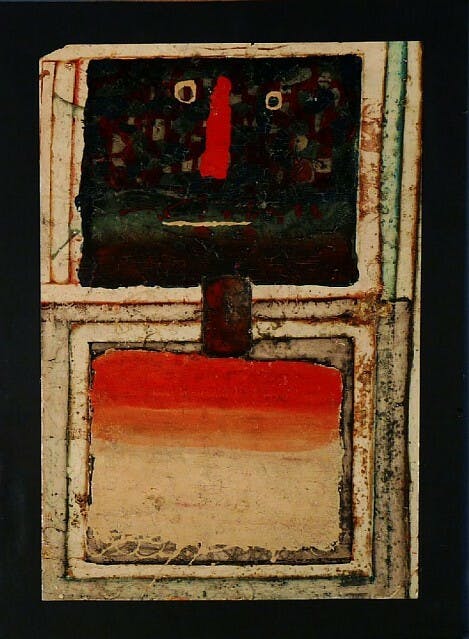
Luis F. Benedit, Untitled, ca. 1960. © Estate of Luis Fernando Benedit.
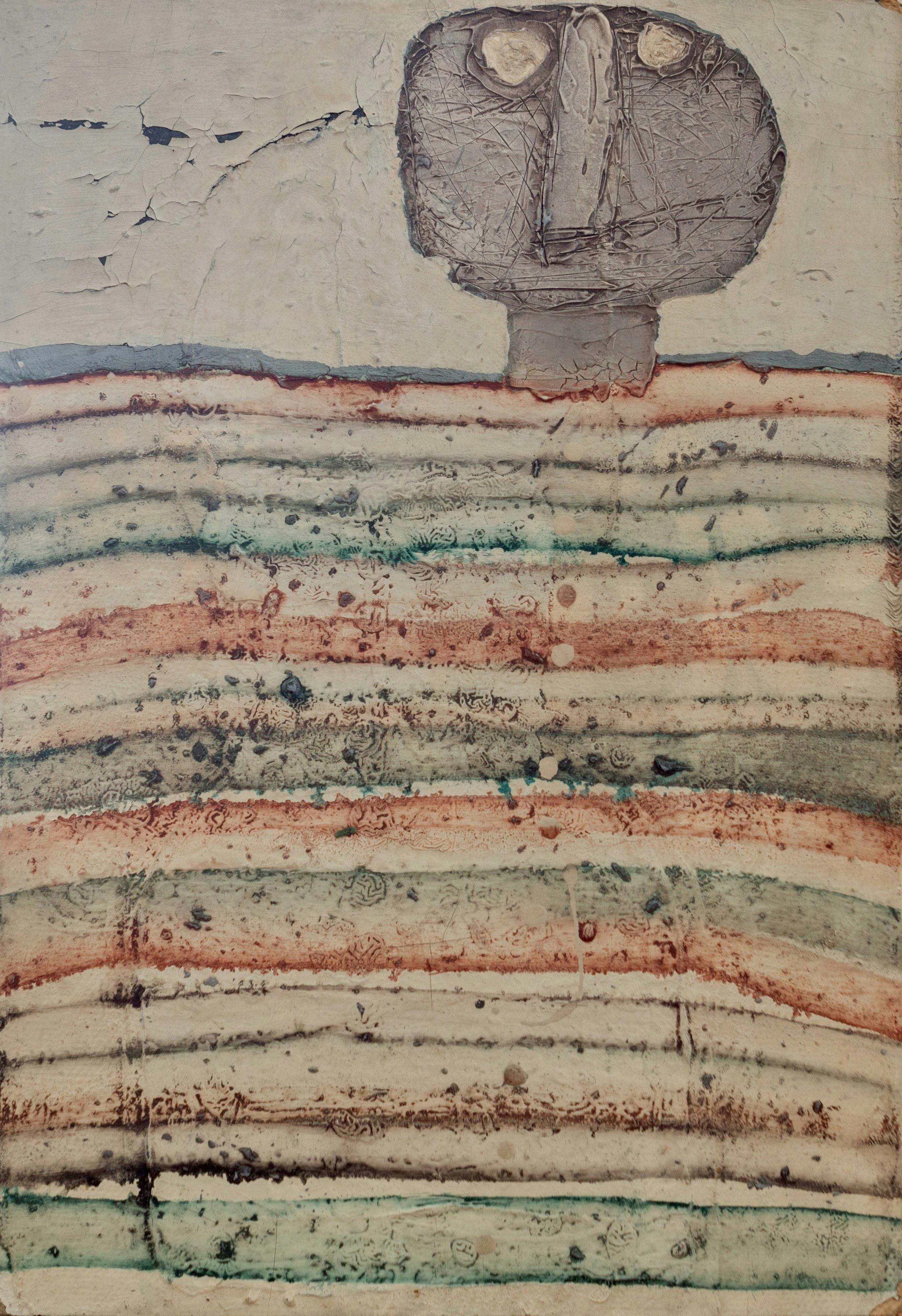
Luis Fernando Benedit, Personaje a rayas, 1961. © Estate of Luis Fernando Benedit.
These works from the first half of the 1960s indicate a burgeoning interest in the various effects made possible by pigment. When seen together, these paintings provide an inventory of gestural techniques and figurative devices. A squat, compact figure sporting a ruffled collar appears in El académico (The Academic) (1961). Its dripped lines of paint and intricate brushwork contrast with El adelantado (The Governor) (1961), in which severe, scored lines compartmentalize the figure’s accoutrements: a square face appears compressed between a top hat and a stiff white collar and necktie. Other works feature still more painterly techniques. Speckled paint, as though applied with an aerosol, produces a haze in La niña luz (The Light Girl) (1961), while blotches of dry paint are used to elaborate the eponymous, stacked stripes of Personaje a rayas (Striped Character) (1961). After almost two years of dedicated work, Benedit held his first solo exhibition at the Galería Lirolay in June 1961. This seminal exhibition heralded an eclectic approach to figuration rooted in the matter of painting.
Benedit’s burgeoning inventory of techniques connected him with international artistic developments. By the 1940s, the French painter Jean Dubuffet was charting a radical path for figuration. Rejecting the bourgeois moral traditions upheld by the art academy, he ventured beyond the accepted boundaries of taste. Even the term he coined,art brut (raw art), emphasized his unruly approach to painting. 2 In sources that ranged from urban graffiti to “primitive” art, he perceived untrammeled expressions of raw emotions and original visions. His disregard for conventions extended to his choice of materials. Unsatisfied with the effects of standard pigments, he incorporated mud, sand, gravel, and glass. That Benedit employed similar formal and material tactics was noted by the critic and museum director Rafael Squirru. 3 He was quick to stress, though, that this parallel does not condemn the Argentine artist to the status of imitator, not least because a thread of caustic humor runs through the characters populating his paintings. Reassessing his early works, though, reveals more than distanced irony or naive expressivity lurking in his painterly concretions.
Benedit excels when his material experimentation does not come at the expense of historical reckoning.
Benedit excels when his material experimentation does not come at the expense of historical reckoning. Via the title of his aforementioned El adelantado, Benedit connects eras of monarchic control in Europe and the Spanish invasion of the Americas. From the twelfth century onwards in Spain, an adelantado (literally meaning “advanced,” though connoting “one who goes before”) was a noble who governed a particular region. Once colonization began in the fifteenth century, the term came to signify an official granted military and civic powers to “explore,” conquer, and administer areas in the Mundus Novus, or “New World.” 4 These themes also seem inescapable when viewing Personaje de las invasiones (Character of Invasions) (1961). These references to generic types differentiate Benedit’s practice from that of his major contemporary Luis Felipe Noé, a difference which is especially evident in the Serie Federal. 5 Noé’s paintings also portray historical events and figures, though his references to specific figures from nineteenth-century Argentine history are rendered with such gestural force as to risk illegibility.
Alert to these historical legacies of empire and war, Benedit vests other works with references to both past and present. Mambrú se fue a la guerra (Marlborough Went to War) (1961), featuring a figure in thick impasto and almost sculptural lines, draws its title from a song popularized in the 1960s and 1970s by Argentine pop singer Maria Elena Walsh. It was first sung, though, by French soldiers fighting Spain and England during the War of Succession (1701-1714). Composed following incorrect rumors of the death of the English Duke of Marlborough, it grimly celebrates his supposed fall in battle. Given the then-recent 150th anniversary of Argentine independence, Benedit hints at ongoing struggles for liberation.
Of course, conflict extends far beyond the battlefield. In other works, Benedit addresses intimate, domestic forms of violence. His El segundo uroxicida [sic] (The Second Uxoricide) (1961) sets an isolated figure against a spare, red ground, with little modulation of color, while the spattering of paint alludes to the brutality of femicide. This stark figure attests to a cultural history replete with portrayals of gender-based violence, from Herod’s killing of his second wife to the French tale of serial-slayer Bluebeard. With paint thrown down on the surface across this series of works, the material means of figuration collide with histories of aggression that extend in scale from personal relations to international devastation.
Other artistic developments, closer to home, help frame Benedit’s explorations. In Buenos Aires, the Nueva Figuracióncircle of artists was also interrogating the limits and possibilities of painting and dismantling its historical foundations. 6 Not only did they take aim at the notion of coherent space and illusionistic depiction, but they also attacked the idea that a painting should involve a single support. Of those in the group, Noé proved particularly influential. A focus on chaos, understood as the permanent flux of experience, had motivated his practice since the early 1960s. Juxtaposing contemporary and historical references in works that extended across multiple canvases, he opened new avenues for formal experimentation and political engagement. Although Benedit did not exhibit the same breadth and scale at this early point in his career, he developed an ever more probing impulse towards the possibilities of materials.
Over the following years, Benedit’s international itinerary afforded him opportunities to develop his practice. After graduating from university in 1963, he moved to Madrid to further his architectural studies alongside his burgeoning practice. In November 1965, he held another solo exhibition, this time in Paris at the Galerie Europe. 7 The gallery had a record of showing works by other artists also invested in painting. In 1963, the Dutch painter and sculptor Karel Appel, a member of the artist collective CoBrA, had a solo exhibition, as did Francis Salles in 1965 under the banner of Nouvelle figuration. By the middle of the decade, however, the art brut program, and especially its emphasis on supposedly spontaneous creativity, could no longer answer to an ever more spectacular media environment that shaped both the production and perception of images.
Upon returning to Buenos Aires in 1966, Benedit expanded his range of formats and techniques. Together with Vicente Marotta, he staged Barbazul at the Museo de Arte Moderno de Buenos Aires in late September of that year. 8 Acknowledging the bodily experience brought to the fore by happenings, the exhibition invited visitors to enter a multimedia environment on the ninth floor of the museum. Music composed by Miguel Ángel Rondano accompanied the script, which visitors used to navigate the arrangement of brightly colored works. A series of paintings and sculptures arrayed throughout the space depicted figures from the legend of Bluebeard, the story that gave exhibition its title. The sculptures were constructed from scrap iron and cement before being enameled. With new directions came new support, this time from Natalio Jorge Povarché. He had founded Galería Rubbers in 1957 and quickly established it as a leading international proponent of avant-garde practices.
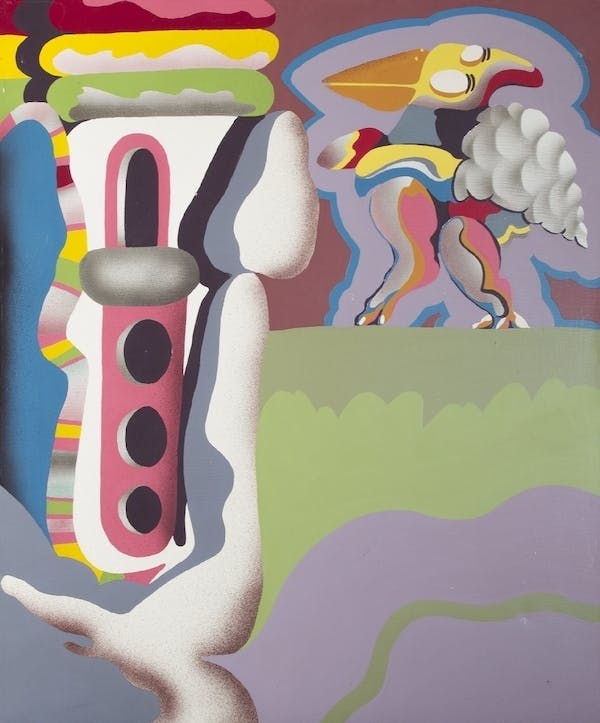
Luis Fernando Benedit, Arquitectura 677/5, 1967. © Estate of Luis Fernando Benedit.
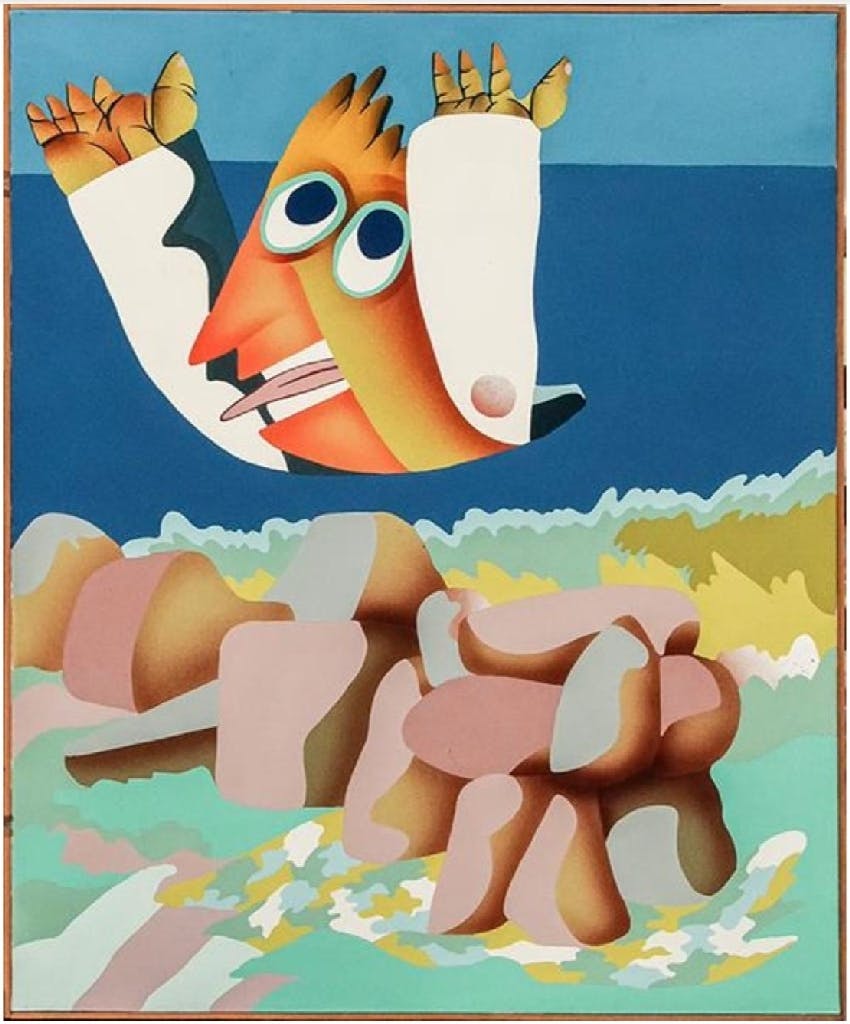
Luis Fernando Benedit, "S.O.S.," 1967. © Estate of Luis Fernando Benedit.
By the time the gallery hosted Benedit for a solo exhibition in April 1967, the artist had embarked on a dramatic shift in his practice. As noted by the critic Aldo Pellegrini, the impasto surfaces and earthy tones were replaced by smooth finishes and a bright, almost pastel, palette. 9 Benedit also jettisoned the tightly cropped, singular characters in favor of ambiguous, seemingly impossible landscapes. A creature, perhaps a mythic griffin, lurks in the corner of Arquitectura 677/5 (1967), offset against the intimations of a built structure on the left. In S.O.S. (1967), a large figure, arms outstretched, calls for help while adrift in the sea. The areas of even color, from the navy expanse of the ocean to the variegated swell of the landscape’s foreground, double as an abstract composition. With only the barest hints of gray to indicate volume, Benedit almost entirely evacuates depth from these works. By staying so close to the surface of things, he paves the way for a turn towards the presentation of scenarios rather than their representation.
The final years of the decade point to a substantial shift in his practice. After receiving a scholarship in 1967, he traveled to Rome to study landscape architecture with Francesco Fariello. The trip proved decisive for his practice. Although indications of the natural environment had emerged in his earliest works, Benedit was still focused on figuration. In these years, he reoriented his practice once again. Drawing on scientific resources, he would soon incorporate living organisms into his works. One possible explanation for this shift towards biology is that Benedit encountered Jannis Kounellis’s exhibition of live cacti in steel containers at L’Attico in Rome between November and December of 1967. 10 Certainly, Kounellis’s use of living plants provided a precedent. However, this juxtaposition of artificial regimentation and natural growth did not fully accord with Benedit’s understanding of nature in the postwar period. Amidst the tensions of the Cold War, he recognized that a techno-scientific viewpoint was gaining traction as the exemplary model for understanding the world, a model that was ever harder to avoid and that undermined distinctions between culture and nature.
In 1968, a year now mythic in its radical promise, Benedit embarked on his own small revolution. Although his paintings manifested an interest in the contingencies of material, they remained static objects. No longer confined to depictions of life, on the model of the nature morte, Benedit introduced the nature vivante. First shown in the group exhibition Materiales, nuevas técnicas, nuevas expresiones in late 1968, these small-scale, artificial habitats were crafted from clear acrylic and Plexiglas and used to house various live animals and plants. Ants scurried around obstacles, bees navigated through pathways. In his essay in the catalogue for Benedit’s solo exhibition Microzoo, held at Galería Rubbers in November 1968, critic and curator Jorge Glusberg described the specific temporal dynamics of these works: the microcosm of the habitats unfolded in “the same space and time” as the viewer. 11 Certainly, happenings had also involved spectators in real-time events, but Benedit insisted upon non-human processes of continual differentiation. This focus on dynamic relations chimed with scientific models provided by cybernetics and systems theory. In language reminiscent of these fields, Glusberg notes that Benedit’s “models exist independently of the audience, and systems of control, interaction, and autonomy become the truly desirable values.” 12 Beyond their formal innovativeness, works from the years around 1970 demonstrate the application of empirical techniques and theoretical concepts associated with the sciences.
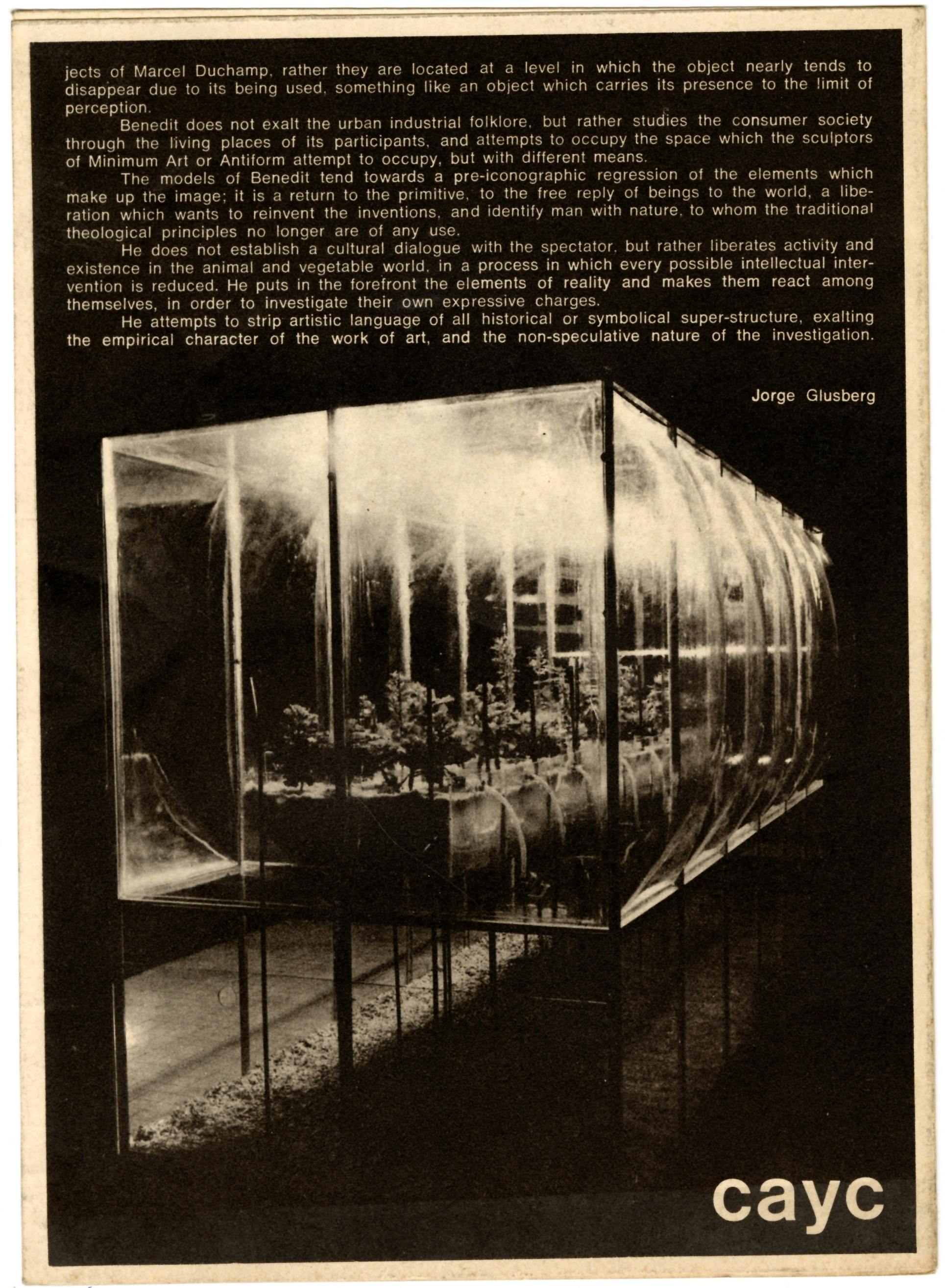
Announcement for Benedit's installation of Phitotron at the Museum of Modern Art, New York, 1972. Pamphlet circulated by the Centro de Arte y Comunicación (CAYC), Buenos Aires.
Professional success allowed Benedit to pursue these problems at greater scale. At the 35th Venice Biennale, he presentedBiotrón(1970), a large-scale artificial environment planned and constructed with the assistance of scientists Antonio Battro and José Núñez. Installed in the Argentine pavilion, this assemblage of metal, glass, and plastic housed a colony of bees. For sustenance, the bees were provided a choice between natural nectar, produced by plants in the gardens surrounding the pavilion, or a glucose solution, supplied by twenty-five plastic flowers controlled by an electronic system. 13 Recognizing that distinctions between nature and artifice were being eroded, in keeping with a cybernetic approach Benedit observed that the bees preferred the synthetic nectar. 14 In 1972, he reached another milestone as the first artist from Latin America to feature in the Museum of Modern Art’s Projects series. The main exhibit was thePhitotron, a hydroponic greenhouse filled with dozens of tomato and lettuce plants. This hermetic environment optimized the plants’ growth through a combination of artificial light and chemical sustenance. Unfolding over six weeks, the exhibition allowed viewers to observe gradual changes in this carefully calibrated system. These projects indicated the fundamental problem of separating nature from culture, not least of all because the methods of the latter are the very means of observing the processes of the former.
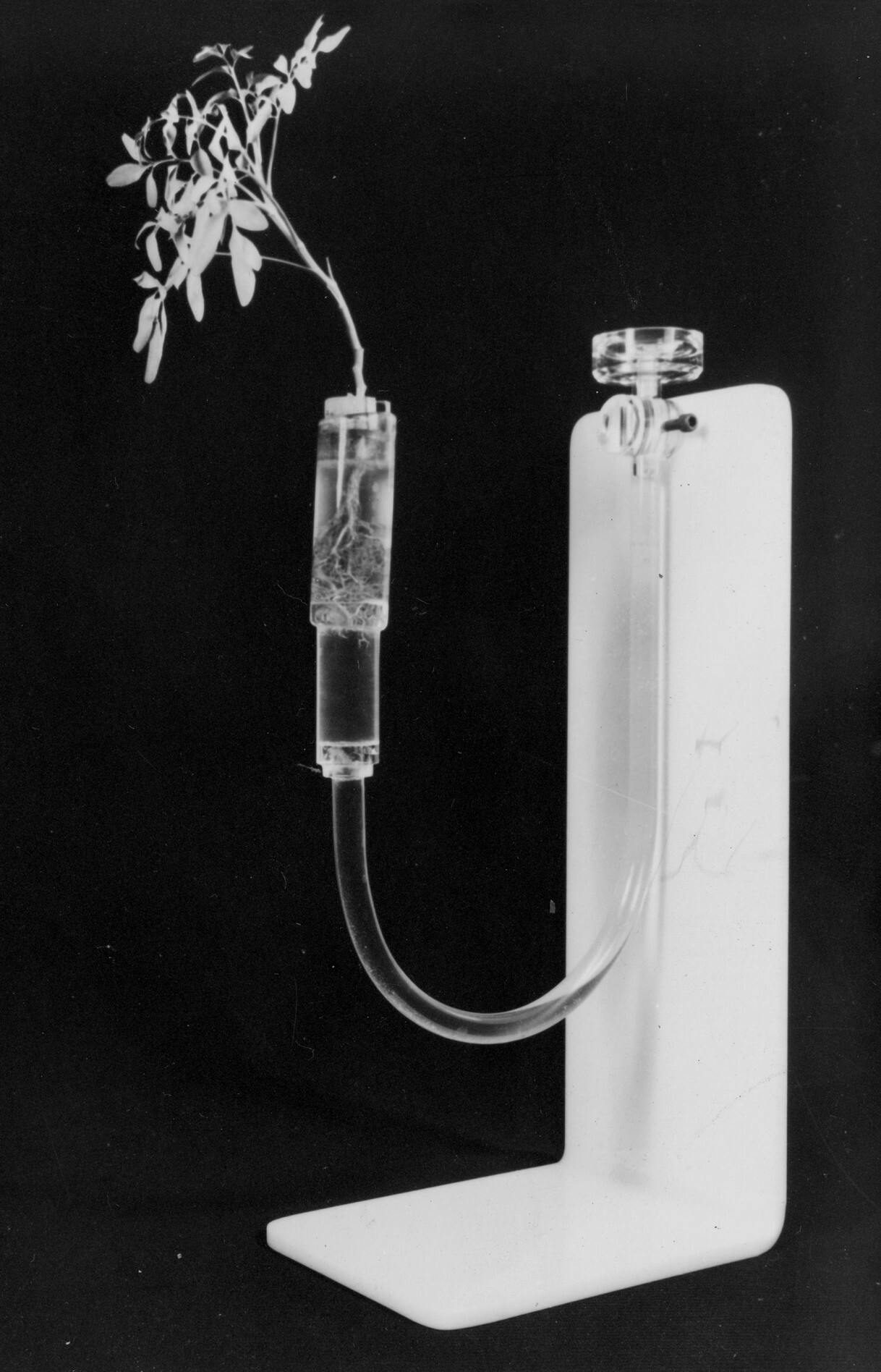
Luis Fernando Benedit, "Evaporador de Sachs" (Sachs Evaporator), 1972. © Estate of Luis Fernando Benedit.
Benedit does not share the explanatory impulse of the scientist. Despite the possibilities of close scrutiny afforded by material transparency, the precise content of this disclosure is not entirely clear. After all, no motivations are ascribed to the works’ “inhabitants,” no intentions explicated, and no desires analyzed.
These works raise the issue of visual perception as a path towards knowledge. As in the microenvironments, spectators were able to closely inspect these assemblages and carefully note any changes. Indeed, from the outset Benedit accorded a significant position to the observer. Preparatory sketches show how spectators were crucial to the planning and scale of the works. 15 At the same time, it is not self-evident that visual examination will provide insights into such complex biological and technical phenomena. In that respect, Benedit does not share the explanatory impulse of the scientist. Despite the possibilities of close scrutiny afforded by material transparency, the precise content of this disclosure is not entirely clear. After all, no motivations are ascribed to the works’ “inhabitants,” no intentions explicated, and no desires analyzed.
As though to reinforce the notion that observation does not guarantee knowledge, another key work foregoes transparency altogether in favor of a black box. His Laberinto Vegetal (Vegetal Labyrinth) (1972) comprises a maze for plants. His custom-built grow box contains a series of partitions, modeled on a rectangular grid. 16 These establish a pathway for the plant, which grows along this snaking corridor towards a light bulb at the other end of the box. Once again, growth in artificial circumstances produces an evolving form, this time hidden from view. In fact, peering into the box by removing its lightproof lid would only interrupt the experiment. Offering a twist on the famous problem afflicting Schrödinger’s cat, Benedit establishes a situation in which the very attempt to inspect the conditions would change them. Consequently, these works challenge the divisions at the basis of the natural sciences, that between active subjects and passive objects.
The careful calibration of biological processes by technological systems provides a key avenue for reconsidering the role of interdisciplinary practice in histories of postwar art. Recently, art historians have observed that political history continues to dominate accounts of Latin American conceptualism and related practices. Although necessary, this focus comes at the expense of reckoning with artists’ engagements with techno-scientific concepts. 17 Along those lines, one may note not only Benedit’s engagements with cybernetics and systems theory, but also his familiarity with prewar studies of behavior. His notebooks contain references, for example, to the “trial and error” model of learning developed by the psychologist Edward Lee Thorndike in the late nineteenth century. 18 One could also inquire into the ways in which scientific discourses were mediated through other forms of practice. The breadth of material within the Benedit Archive provides a basis for just such a historiographical intervention. His notebooks reveal how he repurposed his professional training to carefully devise his habitats. Works are often depicted from the multiple views typical of the architect, including axonometric projections and elevations. Other works were based on floor plans and projections, as in his sketches for Laberinto Vegetal. 19 These volumes of notebooks illuminate how Benedit uses the rigors of architecture to stage the contingencies of biology.
An emphasis on processes also provides a basis for considering Benedit’s contribution to contemporary reflections on materiality. The anthropologist Tim Ingold maintains that attempts to understand the material world all too frequently inhibit it by freezing its contingency into what we call objects. But those temporary appearances of stasis are a matter of mindset, marking nothing but our own inability to perceive and comprehend the multiplicity of transformations that comprise the world. Questions of being must, therefore, be replaced by matters of becoming. To do so, Ingold suggests that we focus on materials, understood as matter permanently in flux, always able to be transformed. Only by reckoning with the ways in which materials, both animate and inanimate, become entangled with environments can we develop a properly ecological form of understanding. 20 Just such conditions provide the operative dimension of Benedit’s habitats. Whether containing mice or ants, fish or plants, his materials and environments constantly reconfigure one another in new patterns and arrangements. In this sense, Benedit questions the very idea that the work of art can be understood as ideal form imposed on brute matter. By the same token, he implies that overcoming disciplinary boundaries by entangling the arts and sciences may precipitate new ecologies of knowledge.
The depth of the archive casts further light on the structures of knowledge that Benedit interrogates. Of particular concern are the divisions between culture, nature, and technology. 21 His Evaporador de Sachs (Sachs Evaporator) (1972) is a simple watering mechanism for a plant housed in an acrylic tube. The work, whose title alludes to the nineteenth-century German botanist Julius von Sachs, demonstrates the process of transpiration whereby water is absorbed, internally circulated and evaporated through the leaves. Benedit’s materials allow the system to be carefully observed, even allowing for detailed measurements of water. For all this precision, though, the processes he institutes are by no means self-explanatory. A collaged preparatory drawing for the Evaporador de Sachs (1971) shows how the plant becomes part of the scientific equipment, another device for converting water into oxygen. Beyond the vegetal, other works render permeable the boundaries between the animal and the synthetic. Proyecto para una oruga (Project for a Caterpillar) (1975) seems to show a larger-than-life caterpillar, complete with camouflage markings, yet its interior is fully mechanized. The watercolor Natural/Artificial 2 (1976) also posits a form of integration. An insect appears attached to a planter via an articulated arm, a combination that mechanizes the process of pollination. These assemblages suggest that animal, vegetal, and technical processes may comprise a single, unfolding process of energetic and material exchange yet also probe the limits of their compatibility.
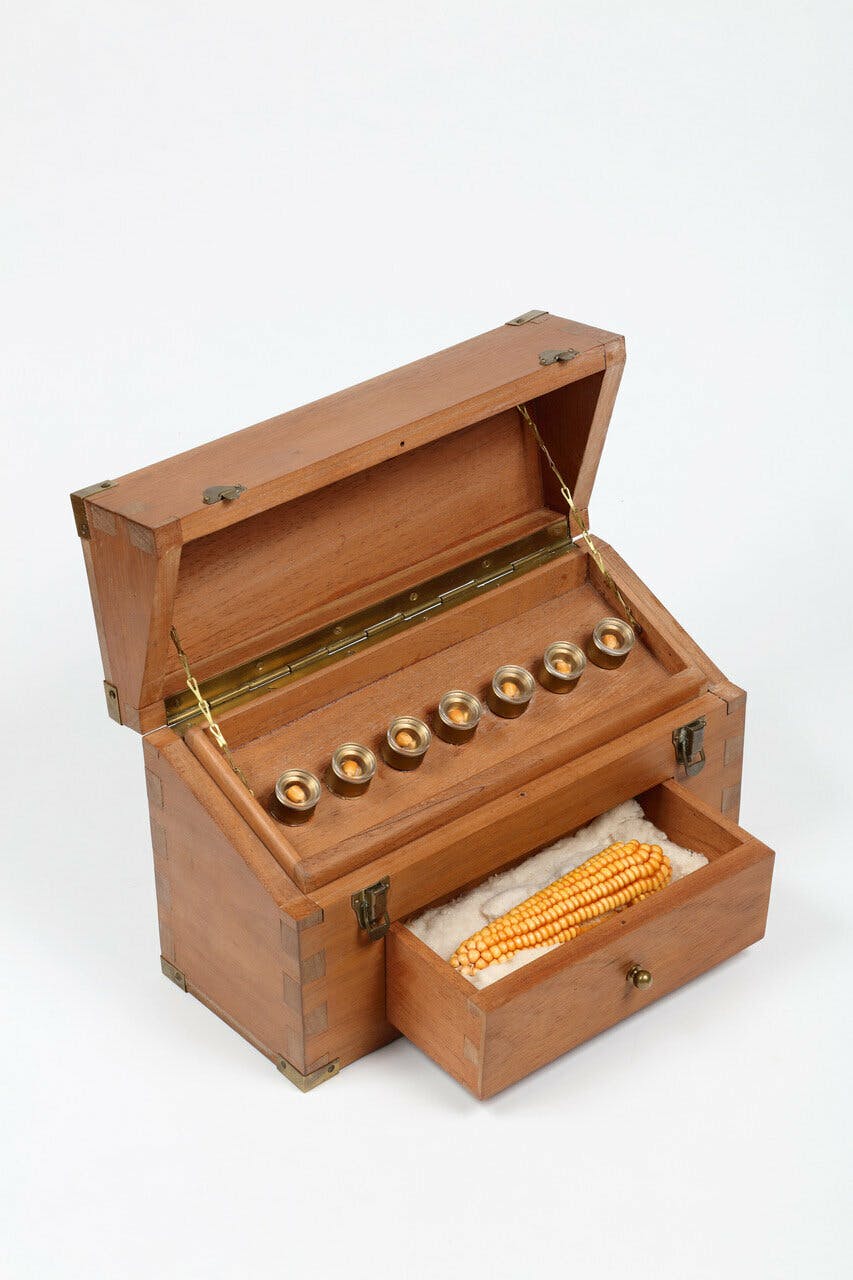
Luis F. Benedit, Caja de maíz (Box of Corn), 1978. © Estate of Luis Fernando Benedit.
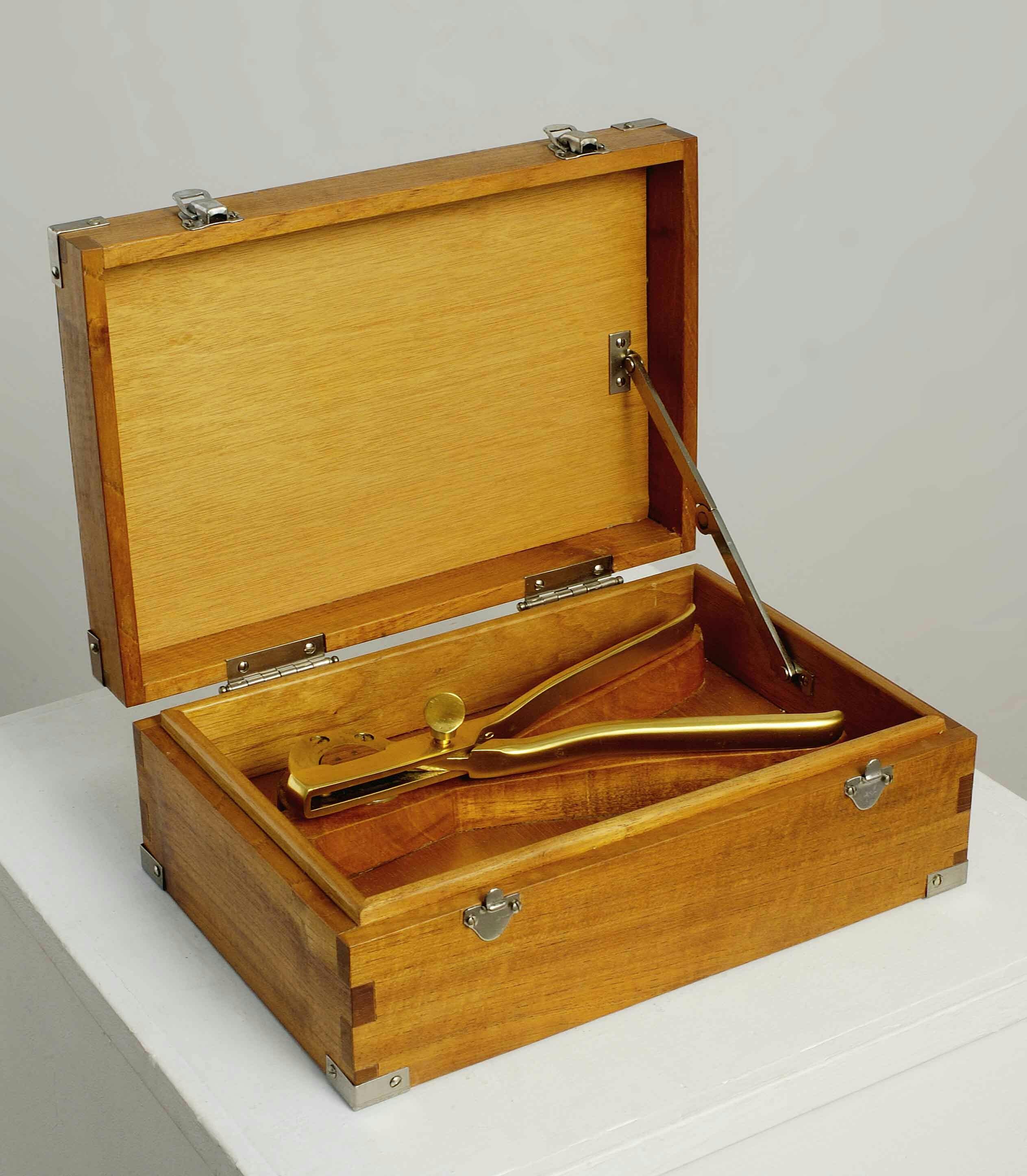
Luis F. Benedit, Tijeras para castrar (Spaying Scissors), 1978. © Estate of Luis Fernando Benedit.
Throughout the decade Benedit continued to explore these disciplinary intersections, though his focus shifted towards the processes and means of domestication. His Tijeras para castrar (Spaying Scissors) (1978) displays an essential agricultural tool. Isolated and neatly packaged, the implements become emblems of intervention in the reproductive cycle. As well as aiding in the management of cattle populations, sterilization also effected hormonal changes that typically resulted in more docile behavior. Another small-scale piece, Caja de maíz (Box of Corn) (1978), features a cob of corn as a fragment of nature along with seven airtight containers for preserving seeds.
These works open onto deeper histories of control. The political scientist James C. Scott has argued that practices such as rearing livestock and cultivating grain form part of a history of control over nature, and reproduction in particular, that contributes to the accumulation of political power. 22 These materials, of course, resonate with the conditions in which Benedit worked. Indigenous peoples of the Americas had first domesticated maize as a staple crop necessary to the survival of the community. By the time Benedit was working, maize had become another kind of staple: a globally traded, fungible commodity. Argentinian beef had also entered the export market, owing to the vast, fertile Pampas of the country’s interior. Taken together, these sculptural works indicate how various systems, whether cultural, economic or scientific, attempt to arrest the contingencies of the material world.
Surveying Benedit’s archive makes evident that his concern with processes may double as a warning. To erect disciplines of knowledge means elaborating fields for inquiry as much as cultivating techniques for control. In attempting to manage bodies and materials, we must reflect on the consequences for our own position in the environment. As designers of habitats and tools, we constantly employ implements of coercion that appear inextricable from our own survival. If we can no longer pretend that we are merely external observers of the planetary system, then we must confront the fact that domination of the environment is coterminous with domination of ourselves. To reckon with this condition also requires that we address our own fantasies of control. Whether cultural or natural, systems have a tendency to exceed our capacity to govern them. Prospects of systemic collapse press us to rethink the very basis on which we elaborate our structures of knowledge and value. Benedit shows us that de-structuring the disciplines and disorganizing their limits will be necessary first steps on the way towards non-coercive forms of life.